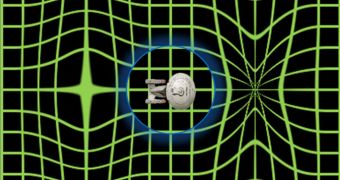Mexican physicist Miguel Alcubierre proposed in 1994 a mathematical model for creating a space drive that could theoretically propel a spacecraft faster than the speed of light. Real simulations show that such a drive would indeed propel a spaceship, but only up to 25 percent of light speed.
In Alcubierre's original model, a vessel outfitted with the drives he proposed would have been capable of traveling faster than light, but not in a localized sense.
In order to understand what that means, we first need to look at what the experts hypothesized. In his through experiment, the physicist advocated for the creation of a new type of space engine.
The warp drive would be capable of creating a warp bubble around a spacecraft, by contracting the fabric of space-time in front of the vessel, and expanding it at the rear.
This would cause the bubble to “glide” forward on the ensuing wave, therefore circumventing any type of contradictions this model may have had with Einstein's physics. In theory, such a drive is possible.
It is important to note here that, even if the bubble travels faster than the speed of light, the spacecraft does not travel faster than light inside the bubble. The structure is a closed system, where every normal law of Einstein's physics still applies.
There are naturally limitations to this, and a whole range of problems that need to be worked out before warp drives become a reality. Still, models show that Alcubierre may have exaggerated in his theory.
Recently, a team of scientists decided to use a mathematically-modeled metamaterial as part of a simulation to see whether an Alcubierre drive would actually allow for light speed transportation.
The most important conclusion is that such a drive cannot break the light barrier. However, the scientists were pleasantly surprised to learn that the bubble can reach speeds up to 25 percent that of light, or 74,948,114 meters per second.
While this isn't 300 kilometers per second, its still a very good speed, researchers admit.
With a spacecraft capable of reaching this velocity, a crew of astronauts could reach the Alpha Centauri system in just 17 years, which is perfectly feasible from the point of view of a human lifespan.
These calculations were carried out considering that the acceleration and deceleration phases of the journey will take only minimal amounts of time, Universe Today reports.
Scientists say that the idea is therefore definitely worth exploring, and that technology based on it could indeed be used in the future to create spacecrafts capable of taking us among the stars.

 14 DAY TRIAL //
14 DAY TRIAL //